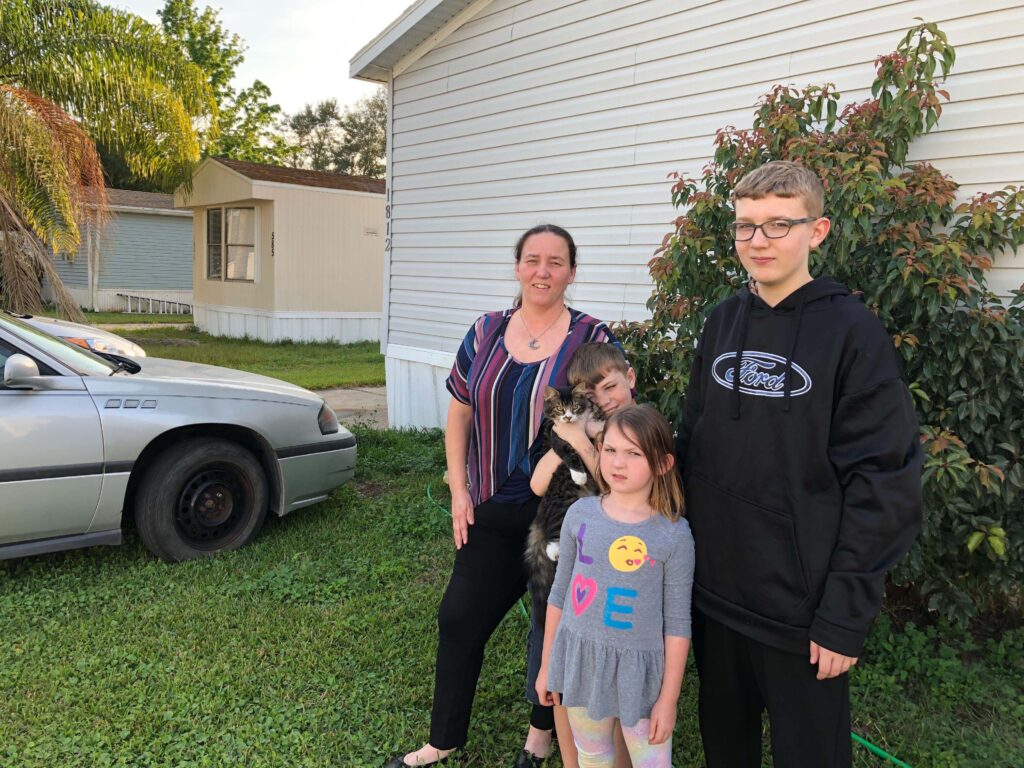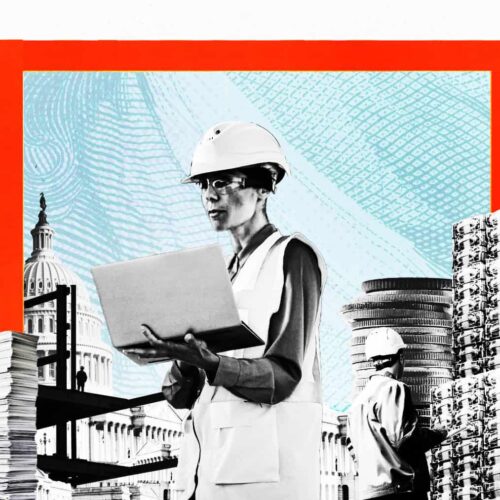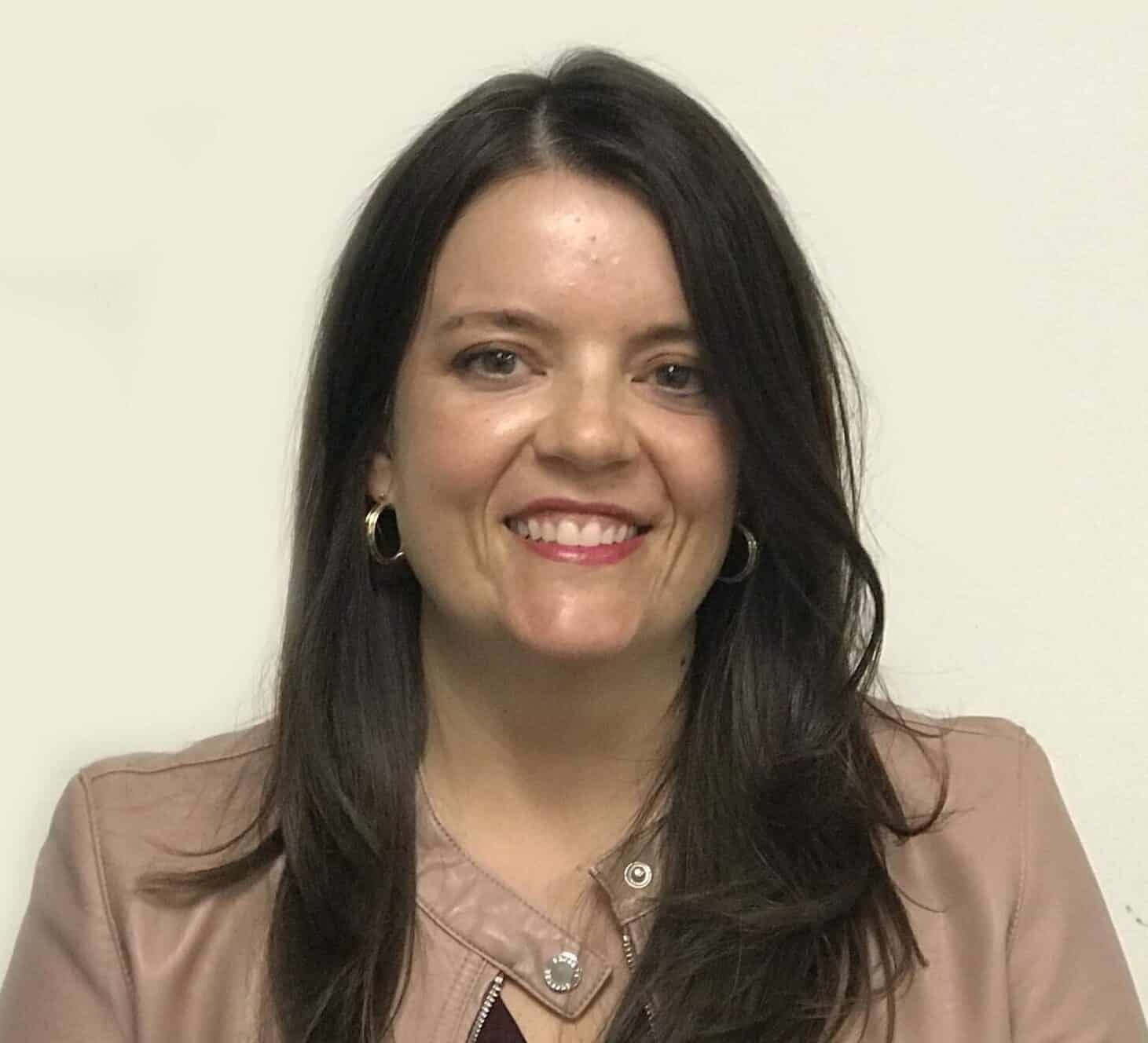This story was published in partnership with Vox. The Center for Public Integrity is a nonprofit newsroom that investigates betrayals of public trust. Sign up to receive our stories.
Introduction
ORLANDO, Florida — Elizabeth Evju’s cellphone was ringing nonstop on Dec. 6, 2018.
Evju was at work, serving soft drinks to guests at Disney’s Animal Kingdom park that morning, and couldn’t answer. It wasn’t until lunchtime that she saw the text message.
“This is Chaplain Glen, and I’m trying to get ahold of you. It’s an emergency, please call me back.”
The 40-year-old mother of six couldn’t imagine what it was all about. She would learn, soon enough, that her partner of 13 years, Shawn Knowles, had been crushed in a work accident.
Knowles didn’t survive, the chaplain told Evju on the phone. “I just lost it,” she said, sobbing as she remembered the conversation. “I was screaming and crying and screaming. I couldn’t even speak.”
Knowles worked at a countertop factory and had arrived early that day. He was cleaning out the drainage ditch that collects granite dust from a 28,000-pound marble-cutting machine. As he hosed down the ditch, he stepped into the path of the machine’s robotic arm before it circled back to switch tools.
The area wasn’t roped off, investigators said afterward; nothing kept workers from taking the wrong step.
No one saw what happened next, according to police, but one of Knowles’ coworkers, Brady Claiborne, found him lying in the drainage ditch at around 8:40 a.m., his arm bloody and twisted into an “unnatural position.” Claiborne yelled for someone to call 911. Two coworkers rushed over. Together, they lifted Knowles out of the ditch and turned on a heater to keep him warm until an ambulance arrived. He was still breathing.
Less than an hour later, on his way to the hospital, Knowles died. He was 44.
“It destroyed us. It really did,” Evju said. His death was so distressing that she couldn’t work for a month and almost lost their home when she fell behind on the mortgage payments. One of their six children tried to commit suicide. Their 11-year-old son still has dreams that his father is alive.

Knowles’ accident was one of 3,203 that led to a death or “catastrophe” — defined by the U.S. Department of Labor as hospitalizations of three or more workers — and triggered an investigation by safety inspectors at the U.S. Occupational Safety and Health Administration during the first three and a half years of Donald Trump’s presidency, according to the agency’s enforcement data.
In 2019, OSHA’s safety inspectors conducted 962 investigations into fatal or catastrophic workplace incidents — the highest number since the agency began publishing the data in 2011.
As these incidents mount, however, the Trump administration has scaled back OSHA inspections, which research has shown to lower injury rates. The agency has conducted slightly fewer safety inspections during the first three years of Trump’s presidency than during a comparable period at the end of President Barack Obama’s second term, even though the labor force grew by 16 percent, according to a Center for Public Integrity analysis of the agency’s inspection data.
Amid the COVID-19 pandemic, OSHA has been cutting back even more, conducting only 5,127 inspections since March 13, when Trump declared the coronavirus a national emergency. That’s a drop of about two-thirds compared to the same period last year.
The slowdown in inspections could prove dangerous for millions of workers: A Public Integrity analysis shows the vast majority of deaths and catastrophes have occurred at workplaces that weren’t inspected by OSHA.
A case in point is Majestic Marble & Granite, the countertop factory where Knowles worked. Before the 2018 accident, it had never been inspected by OSHA, records show, despite being part of a hazardous industry. Under federal law, the agency doesn’t need to visit every workplace — an impossibility given that it has never had more than 1,500 inspectors to cover millions of workplaces. Under Trump, scrutiny is even less likely.
The lax scrutiny comes as Trump continues to trim the regulatory powers of federal agencies. Under his watch, the Labor Department has systematically weakened rules meant to protect workers’ pay, retirement and safety.
The department, for example, scaled back a rule to extend overtime pay for millions of workers. It also tried to change pay rules to let employers pocket workers’ tips — a move later undone by Congress. And it has been slow to hire and replace inspectors at OSHA; their number fell from 952 in 2016 to 862 in January, the lowest in the agency’s history, according to the National Employment Law Project.
The number has since gone down to 761, according to the Labor Department.
Debbie Berkowitz, who served as an OSHA policy adviser under Obama, said the administration is “starving” the agency of the staff it needs to keep workers safe.
“This will have lasting consequences,” said Berkowitz, now NELP’s director of safety and health. “It’s undermining the effectiveness of the agency.”
The human cost of less regulation
There was a time when deaths and maimings at workplaces were common. During the Industrial Revolution, factories sprang up in the Northeast, and working conditions there were brutal. Fires, explosions and equipment malfunctions were frequent. Workers died, and employers had no legal obligation to protect them.
In 1860, a cotton factory in Lawrence, Massachusetts, collapsed and killed about 145 workers. That led the state to pass the nation’s first law requiring factory safety inspections. New Jersey, New York and a handful of other states followed.
It wasn’t until the progressive New Deal era that the federal government got involved. In 1934, Frances Perkins, the first labor secretary, opened an agency to help states craft and improve workplace safety laws.
Then, under pressure from labor unions, Congress passed the Occupational Safety and Health Act of 1970. It required all private companies — for the first time — to provide workers with a safe and healthy work environment. OSHA was created to enforce the law.
While it doesn’t inspect every workplace, OSHA is the primary agency to enforce workplace safety laws in 29 states. (The other 21 states have their own enforcement programs that must comply with federal law.)
Still, even with OSHA in place, critics say workplaces across the country remain dangerous, triggering an annual average of about 880 fatal or catastrophic investigations from 2012 to 2019.
The death toll is “outrageously high,” says Marcy Goldstein-Gelb, co-executive director of the National Council for Occupational Safety and Health, an advocacy group. “With all the technology we have, those rates should be going down much more dramatically.”
One reason for the high number of deaths and catastrophes is that the workforce was growing before the pandemic hit, so there were more workers at risk of getting hurt.
But Goldstein and other workplace safety experts believe more workers are dying because OSHA inspections have grown rarer.
During the first three years under Trump, OSHA conducted about 81,000 safety inspections — a 4.7 percent decrease from about 85,000 conducted during the last three years of Obama’s presidency, according to a Public Integrity analysis of the agency’s inspection data.
“Unless someone dies at a workplace or there’s some significant accident, [the employer] is very unlikely to be inspected now,” said a former OSHA official under Obama, who spoke on the condition of anonymity because he is not authorized to speak to the press at his new job.
But Congress hasn’t cut OSHA’s enforcement budget; instead, it has given the agency slightly more funding than the administration has asked for. It earmarked $576.8 million for fiscal year 2020 — $19.3 million more than requested.
Former OSHA officials say the decrease in inspectors has more to do with the federal hiring freeze imposed during Trump’s first year in the office. Dozens of inspectors left their jobs in the months following his inauguration, and the Labor Department has been slow to replace them.
OSHA “has done a poor job filling the vacancies,” said Rebecca Reindel, safety and health director for the AFL-CIO labor federation.
Filling vacancies is the first step to rebuilding the agency, a task a future administration would likely have to take on, Reindel said. She also would like to see OSHA hire more employees to update safety standards — a process that can take years. Ramping up criminal prosecutions of negligent employers is also critical, she added.
“Going after those especially bad actors sends a strong message,” Reindel said.
What happens when OSHA stays away
After Knowles’ death, OSHA cited Majestic Marble & Granite for not putting up guardrails around the drainage ditch and not blocking off the area around the stone-cutting machine while it was on.
Inspectors said the robotic arm likely pushed Knowles and pinned him against a steel I-beam nearby, crushing his arm and torso. The company settled two OSHA citations and paid a fine of $12,199 — down from a proposed penalty of $18,564 — in May 2019.
Evju was furious when she found out. “I couldn’t believe they felt like that’s what his life was worth — not even close,” she said.

Majestic Marble & Granite is just a few miles south of downtown Orlando, on a busy street lined with auto body shops and personal storage units. The building has a showroom up front and a workshop out back. That’s where employees design, cut and polish the countertops.
The owner of the company, Scott Hanes, declined to talk about what happened on Dec. 6, 2018.
“I can’t comment on that,” Hanes said in the parking lot one February afternoon. “I need to protect my business.”
At the end of the workday, employees ambled toward their cars, wearing grease-stained, neon yellow T-shirts. They, too, didn’t want to talk.
“I’m sorry, I just can’t,” said one man as he got into his pickup truck. “That brings up some really bad memories of trying to save someone’s life and not being able to.”
Another man said he gave a statement to police and didn’t want to discuss it further.
Majestic Marble & Granite did not have a history of safety complaints or violations, according to OSHA. That’s probably why the agency never visited the business — it often takes a worker to file a complaint or die for OSHA to investigate. But the agency randomly inspects companies in dangerous industries, and the stone fabrication industry was part of its high-hazard safety enforcement program until the administration ended it, shortly after Trump took office. It’s more likely that OSHA would have inspected Majestic Marble & Granite if Trump hadn’t abolished the program. (The administration reinstated a weaker version of it earlier this year.)
The White House declined to comment on Public Integrity’s findings and referred questions to the Labor Department.
Megan Sweeney, a Labor Department spokeswoman, said the number of inspections began to rise again in fiscal year 2019 and was on pace to rise even higher in 2020 until the pandemic hit.
“OSHA is working around the clock to protect America’s workers, especially during the pandemic,” Sweeney wrote in a statement.
But that’s cold comfort for Evju. “I feel like if [OSHA] had actually investigated the company to make sure that it was safe, then my husband would still be here,” she said.
Justin Harrington’s story is similar to Knowles’. Harrington had been looking forward to a career in construction. The 27-year-old New Englander knew how to handle a forklift and wanted to get a special license to drive boom trucks and bucket trucks. He never got the chance.
On Jan. 18, 2018, Harrington died while driving an excavator in Gloucester, Massachusetts. He was digging out the foundation of a house to renovate the basement. None of his coworkers had arrived yet, so no one saw what happened. The owner of the contracting company, Michael MacEachern, found him pinned against a steel beam and called the police.
Harrington didn’t make it. “I’ll never forget that day,” said his mother, Rena.
MacEachern did not respond to a request for comment.
After Harrington’s death, OSHA sent an inspector to the work site and cited the company, Stoneworks, for not properly training employees to recognize and avoid hazards. Stoneworks settled the case for $3,492. As with Majestic Marble & Granite, the agency had never inspected the company until Harrington died, records show.
“Inspections work. If an employer thinks they won’t get inspected, they will take fewer steps to protect workers.”
Rebecca Reindel, safety and health director for the AFL-CIO labor federation
Since January 2013, OSHA has conducted more than 6,800 investigations into workplaces that had a fatal or catastrophic incident. The vast majority of them — about 91 percent — had not been inspected in the previous 10 years, according to a Public Integrity analysis of the agency’s enforcement data.
Research shows that OSHA inspections have a significant impact on safety. In 2012, for example, researchers at Harvard University and the University of California Berkeley found that companies subject to the agency’s random inspections showed a 9.4 percent decrease in injury rates compared with uninspected ones. They also found no evidence of any added cost to inspected companies from complying with regulations.
In 2010, researchers with the RAND Corporation analyzed workers’ compensation data in Pennsylvania and found that OSHA inspections were linked to a sharp decline in reported injuries at medium-size companies. Inspections that led to citations with penalties played a role in reducing injuries by an average of 19 percent to 24 percent each year for the two years following each inspection.
“Inspections work,” said Reindel of the AFL-CIO. “If an employer thinks they won’t get inspected, they will take fewer steps to protect workers.”
Waiting for something to shift
It’s been 19 months since Evju got the news about Knowles, and she still cries about it every day — in the shower, on her way to work in her Buick. “It doesn’t get any easier,” she said.
On her days off — Wednesdays and Thursdays — Evju lies on the couch, too exhausted and sad to do anything. Sometimes she musters the energy to clean her house. The family lives in a trailer park called Rock Springs, where she and Knowles bought a three-bedroom mobile home in 2017.
During a recent visit by a Public Integrity reporter, her home looked tidy but worn. Her daughter’s dolls were piled up in a corner. Three goldfish swam in circles. Evju pointed to a cluster of golf-ball-size rips in the beige carpet. Their dog, Smoke, had anxiously chewed through the fabric after Knowles died.
“He’s still grieving,” Evju said as Smoke napped in an open crate in the living room. The old Staffordshire Terrier is just one reminder of the life that Evju once had. There are many, including the small whiteboard where Knowles wrote her a note in blue marker — something he often did. “Hay Baby I love U!! For Ever.” Evju cracked a smile, remembering how he always misspelled “hey.”

Things are hard financially as well. Without two incomes, Evju works extra hours and sometimes doesn’t return home until 1 a.m. She feels like she’s barely hanging on to her job because she often needs to take unpaid time off when a child is ill.
“I’m the only one who can take care of my kids, so if we’re out sick for a week I can’t go to work,” said Evju, who was furloughed from her $14-an-hour job at Disney during the pandemic.
Evju does get modest workers’ compensation payments related to Knowles’ accident, but the $60 a week can only go so far. She relies on food stamps, and her children are on Medicaid. Evju can’t afford the premiums for her health insurance, so she has none.
The older children are pitching in. Fifteen-year-old Braden has taken up “house mom” duties. He helps watch the younger kids, cooks dinner for them and often puts them to bed. Seventeen-year-old Emily goes to a special high school with flexible hours, which allows her to work part time at a nursing home. She helps pay the bills.
Some days, Evju convinces herself she can be happy again. Most of the time, she’s angry. Angry that Knowles’ company never contacted her to offer condolences. Angry that OSHA had never inspected it until the accident. Reminders of that December morning are everywhere.
“There can be a certain smell or some small thing that brings everything back, like I just got hit in the gut with a ton of bricks,” Evju said. “And everything comes flooding back, like I just got that phone call.”
The code and data behind this story’s analysis is publicly available on GitHub.
This series was made possible through a partnership with Vox.
Read more in Money and Democracy
System Failure
Trump’s obstruction of the 2020 census, explained
The Constitution mandates that everyone be counted in the 2020 census. Trump has stood in the way.
System Failure
The Trump administration’s war on birth control
The Affordable Care Act made birth control more accessible than ever. Then came Trump.






Join the conversation
Show Comments